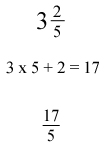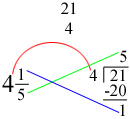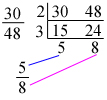This unit begins by reviewing what a fraction is, which shouldn’t be too difficult, as they’ve been working with fractions for a few years now. However, we take a day to bring it back up anyway. In this first lesson we spend just a little time reviewing that a fraction is just a part of a whole number. If you have 3/4, then you could represent it by picture as shown below:
Next is to make sure they understand the proper terminology for the parts of the fraction. Below is a mixed number (a fraction with a whole number) with the parts of it labeled.
We will also talk about converting mixed numbers to fraction form and vice versa. To convert a mixed number to its fraction form you have to multiply there are three steps:
1. Multiple the whole number by the denominator
2. Add the numberator
3. Put that sum back over the original denimonator
Fraction form to mixed number involves these steps:
1. Divide the numerator by the denominator.
2. The quotient is your whole number
3. The remainder is your numerator
4. Keep the original denominator
The final thing we will work on is simplifying. Now, I would like to mention that one of the pushes with the common core is less on the idea of simplest form, and more on the idea of equivalent fractions, so I will cover both here. For simplest form, you have to find the GCF of the numerator and denominator, and then divide them by their GCF. The beauty of the cake method to find the GCF, is that it does this for you. Example:
Equivalent fractions are found simply by either multiplying or dividing the numerator and denominator by the same number. If we take the fraction from, the equivalent fraction to the left is divided by 2, the fraction to the right is multiplied by 2. All three fractions are equivalent.
The easiest way to know if two fractions are equivalent is to take them both to simplest form. Example:






